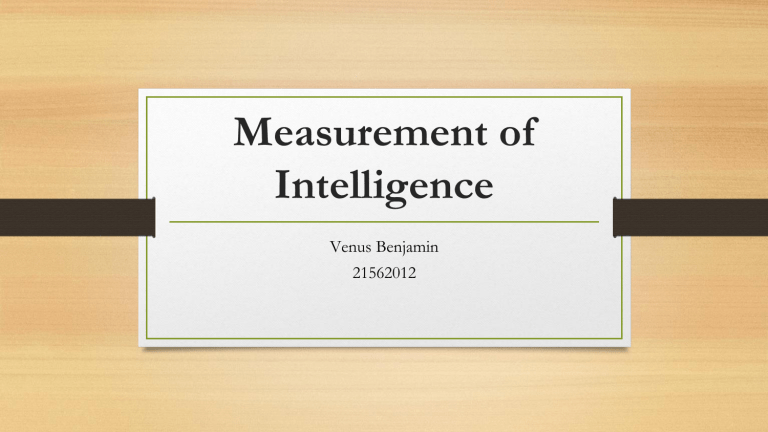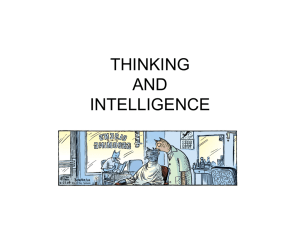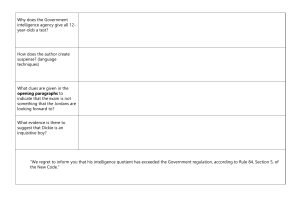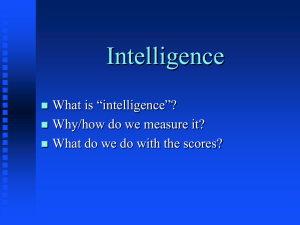
Measurement of Intelligence Venus Benjamin 21562012 What is intelligence? Intelligence has been defined in many ways: the capacity for abstraction, logic, understanding, self-awareness, learning, emotional knowledge, reasoning, planning, creativity, critical thinking, and problem-solving. More generally, it can be described as the ability to perceive or infer information, and to retain it as knowledge to be applied towards adaptive behaviors within an environment or context. Types of measurement of intelligence The general intelligence tests have been classified into three groups. Individual, group and performance tests. ● ● ● Individual Test Group Test Performance Test Individual Test The individual intelligence test is administered to only one individual at a time. A trained psychologist is expected to administer the test for a definite period of time and interpret the result. These tests cover age group from 2 years to 18 years. These are (i) The Binet simon tests, (ii) Revised tests by Terman, (iii) Mental scholastic tests of Burt and (d) Weschler test. Group Test There are two kinds of group intelligence tests verbal and nonverabal. • Verbal The verbal group test requires an individuals to read out certain problems and write out solutions of these problems. • Non-Verbal The non-verbal group tests presents similar problems as the verbal test but in a different way. The problems are presented in the form of pictures,diagrams, puzzles and mazes. If does not require the individual to read or write,but only to be able to make a mark with a pencil. Performance Test Performance tests are designed to test problem solving ability using certain objects such as pictures and blocks, instead of words. These tests are specially useful with young children, illiterates, persons with speech defects and persons who do not have proficiency in language. Some of the famous tests are (i) Koh’s Block design test (ii) The cube construction tests and (iii) The Pass Along tests. Binet-Simon Intelligence Test Alfred Binet and his colleague Theophile Simon first developed the work of measuring intelligence known as the Binet-Simon intelligence test. The test was developed to identify the reason for school children’s bad habits and to take corrective actions. Later, this Binet test was translated and revised by Lewis Terman, and this new edition is called the Stanford-Binet Intelligence test. Continue.. The test contains thirty items, ranging from simple to complex to capture the ability of children of different ages. The test contained copying a drawing, repeating a string of digits, understanding a story, and so on. They collected simple problems that measured higher mental processes such as reasoning, memory, and spatial thinking The Concept of Mental Age Binet conceived the idea of Mental Age (MA) to measure intelligence. Tests were made different age levels. If a test was passed by 60-90% of children of a given age, Binet accepted it for that age level. A child who successfully perform all the tasks acceptable for the five year old child is taken to have a mental age of five, whatever his chronological age (CA) may be Intelligence Quotient Measurement of intelligence in terms of MA raised many problems. To make the comparison easy Stern devised the concept of Intelligence Quotient, popularly known as IQ. The intelligence quotient is an index of the child’s relative level of brightness as compared with the other children of his age. IQ is the ratio between the MA and the CA. It is obtained by dividing the mental age. Revised Test by Terman. After becoming a professor at Stanford, he worked on revising the original Binet-Simon scales for use with American populations. His updated version of the test became known as the Stanford-Binet and went on to become the most widely used IQ test. The third edition of the Stanford–Binet (Terman & Merrill, 1960), could not be directly compared to scores on "true" deviation IQ tests, such as the Wechsler Intelligence Scales, and the later versions of the Stanford–Binet, as those tests compare the performance of examinees to their own age group on a normal distribution (Ruf, 2003). While new features were added, there were no newly created items included in this revision. Thank You!! Ask any questions??



